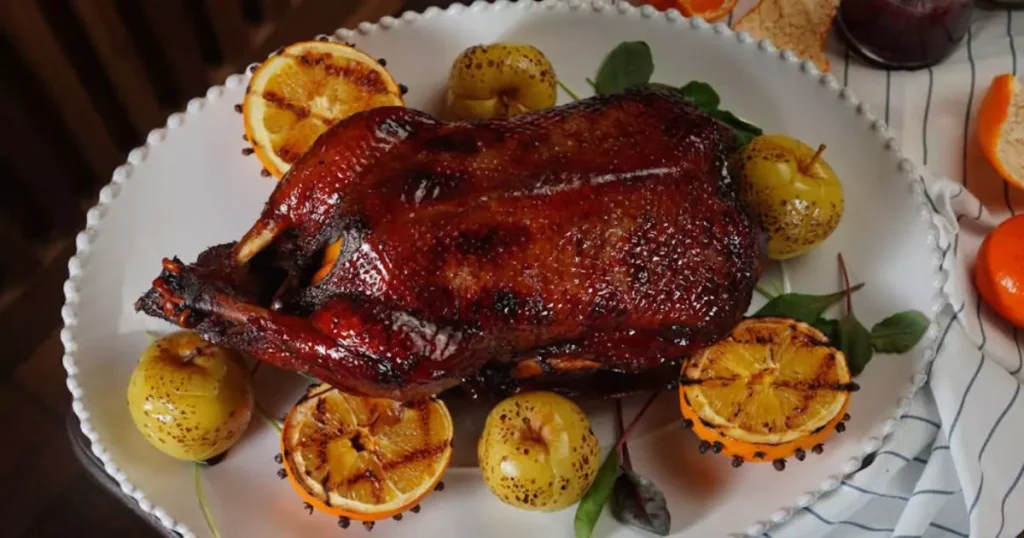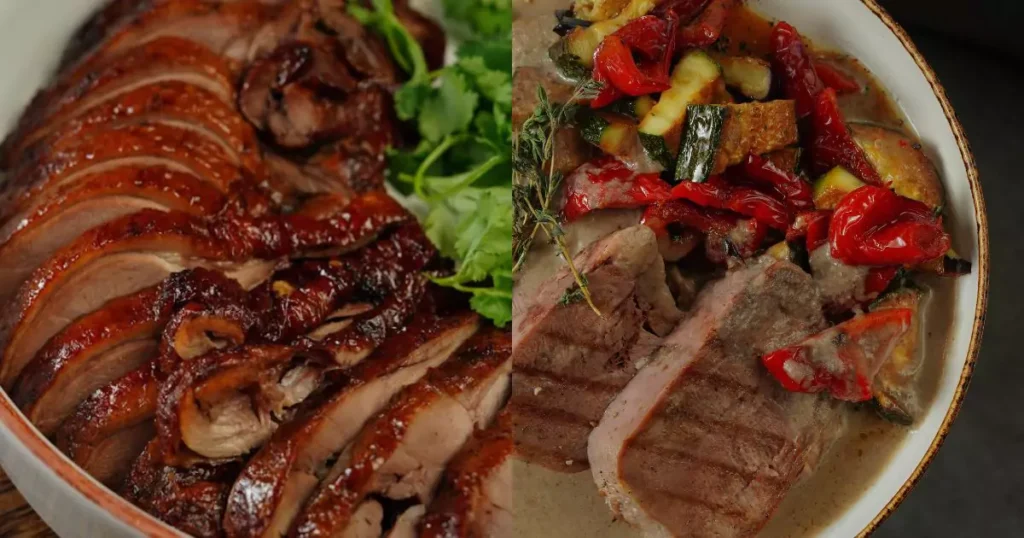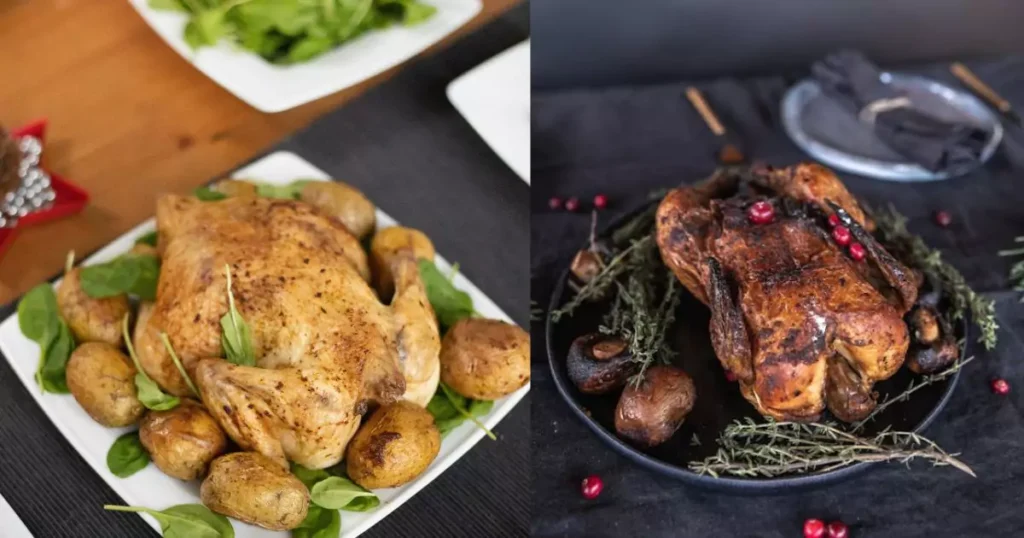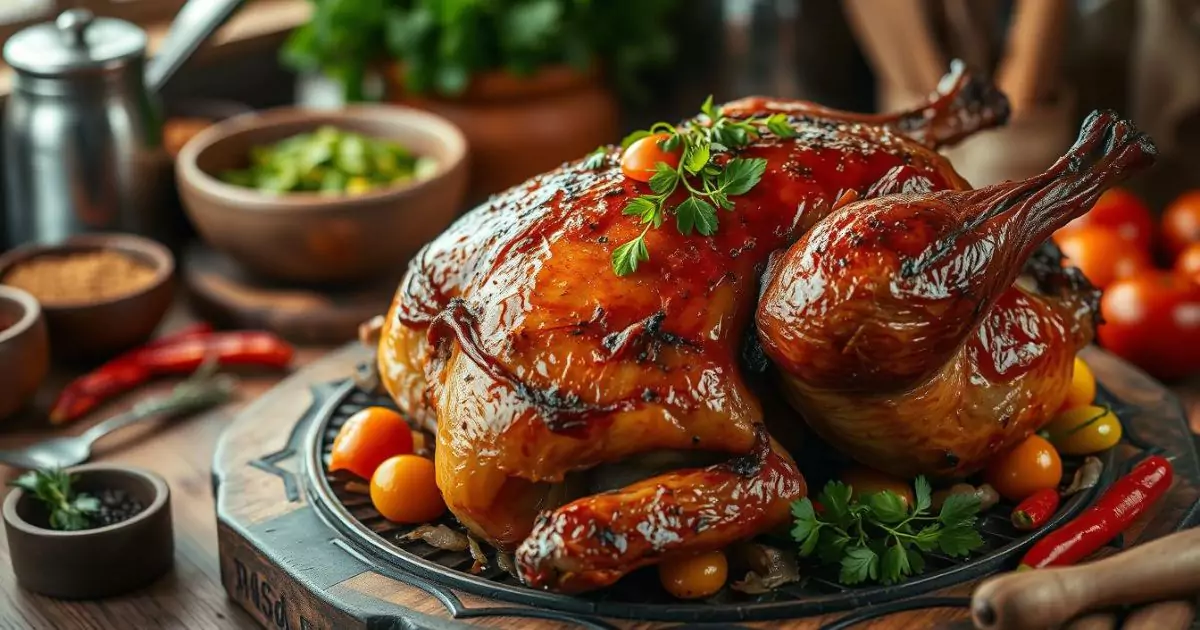can you cook duck like you cook chicken
Table of Contents
When you smell a perfectly roasted chicken, you might think, “Can I cook duck the same way?” The answer is yes, with a few tweaks, you can cook duck just as well as chicken.
Duck might seem scary, but it’s actually a great choice for a delicious meal. It takes a bit more work than chicken, but the results are worth it. You’ll get a crispy skin and juicy meat.
Understanding the Key Differences Between Duck and Chicken
Duck and chicken may look similar, but they are not the same. They have different meat and cooking needs. Knowing these differences is key to cooking success.
Fat Content and Distribution
Duck has a richer flavor and more fatty skin than chicken. Chicken is leaner and tastes milder. The fat in duck affects how it cooks and tastes.
Meat Texture and Structure
Duck meat is denser and fattier than chicken. This is because duck has more fat and is more active. Both duck and chicken are good sources of protein.
Cooking Time Variations
Duck takes longer to cook than chicken because of its fat and density. Cooking duck longer helps melt the fat and makes it tender. For example, duck breast is often cooked until pink, but it must be safe to eat. Duck legs are cooked slowly to make them tender.
Knowing the differences between duck and chicken is crucial for cooking. By understanding their unique qualities, you can cook them perfectly.
Essential Preparation Steps for Cooking Duck
Cooking duck is a bit more work than chicken, but it’s worth it. Understanding duck’s unique qualities and using key preparation techniques can make your dishes taste amazing. You’ll get better flavor and texture in your duck dishes.
Scoring and Pricking Techniques
To get crispy duck skin, start by scoring the skin with a sharp knife. Use a tight, crosshatch pattern. This helps the fat melt out more during cooking.
Also, prick the skin all over with a fork or knife tip. This lets the fat escape, making the skin even crisper.
Pre-cooking Temperature Considerations
Before seasoning, tighten the duck’s pores. Pour boiling water over it and let it sit for a minute or two. This helps the skin contract, preparing it for better fat rendering and crispiness.
Seasoning Methods
- Pat the duck dry with paper towels to help the seasoning stick.
- Make a flavorful paste with garlic, herbs, citrus zest, and spices.
- Rub this paste all over the duck, including the cavity and under the skin.
- Let the seasoned duck rest in the fridge for 4-24 hours. This lets the flavors mix and the skin dry out for crispiness.
By following these steps, you’ll master duck culinary techniques and cooking wild fowl. Impress your guests with your duck preparation skills!

Can You Cook Duck Like You Cook Chicken: The Truth Revealed
Duck and chicken are both poultry, but they need different cooking methods. Duck needs special techniques to get its fat right and skin crispy. Cooking chicken is simpler. The cooking times and temperatures also change between these two birds.
You can’t just cook duck like chicken. Duck is cooked at a lower temperature than chicken. It’s usually cooked to 130°F to 135°F for medium-rare. This keeps the duck moist and tasty.
| Characteristic | Duck | Chicken |
|---|---|---|
| Fat Content | Higher | Lower |
| Cooking Time | Longer | Shorter |
| Internal Temperature | 130°F – 135°F | 165°F |
But, with the right prep and cooking, duck can be as easy to cook as chicken. It’s all about knowing how to cook duck right. Learning how to cook duck well lets you enjoy its rich flavor and crispy skin.
Temperature and Timing Guidelines for Perfect Duck
Cooking duck is a fun culinary journey, but it’s different from cooking chicken. To get that perfect golden-brown skin and juicy meat, focus on the right cooking temperatures and times. Here are the key tips to make your duck dishes a hit every time.
Optimal Cooking Temperatures
For a whole duck, preheat your oven to 450°F (232°C) for the first 30 minutes. This step helps melt the fat and crisp the skin. Then, lower the heat to 350°F (175°C) and roast for another 1 to 1.75 hours, depending on the duck’s size.
For duck breasts, cook them skin-side down in a cold pan, gradually warming it up. This method slowly melts the fat, making the skin crispy. Cook the breasts for 6-7 minutes on the skin side, then flip and cook for 5 more minutes for medium-rare.
Duration Guidelines by Cut
- Whole Duck: 30 minutes at 450°F (232°C), then 1-1.75 hours at 350°F (175°C)
- Duck Breasts: 6-7 minutes skin-side down, 5 minutes on the other side
- Duck Legs: 1.5-2 hours at 350°F (175°C)
Internal Temperature Requirements
For safety, the duck’s internal temperature should hit 165°F (74°C) at the thickest thigh part. But for the best taste and texture, cook the breast to 130-140°F (54-60°C) for a medium-rare to medium doneness.
It’s crucial to let the duck rest for 6-8 minutes after cooking. This allows the juices to spread evenly, making the duck juicy and flavorful.
“Cooking a fatty duck properly involves rendering the fat to avoid chewy skin.

Mastering Duck Breast Preparation
Cooking duck like a pro starts with mastering duck breast preparation. Unlike chicken, duck breasts need a special touch to bring out their flavor. With a few key techniques, you can make your duck breast cooking top-notch.
The secret to perfect duck breasts is in the pre-cooking prep. Start by scoring the skin in a criss-cross pattern. This helps render the fat and makes the skin crisp. Also, prick the skin with a fork to help drain fat during cooking.
Next, season the duck breasts well with salt. Let them sit in the fridge for at least 24 hours, or up to 48 hours. This curing process tenderizes the meat and intensifies the flavors. You’ll see the duck breasts shrink and tighten, showing a deep red color beneath the skin.
To cook, start in a cold pan, skin-side down. Slowly heat it up to render the fat and crisp the skin. This can take 10-15 minutes. Pour off excess fat as it accumulates to get a golden-brown skin.
Flip the duck breasts and cook for about 5 minutes for medium-rare. The internal temperature should be 130°F (54°C) for a perfect pink center. Let the duck breasts rest for 10 minutes before slicing. This helps the juices spread evenly throughout the meat.
Serve your expertly cooked duck breasts with a simple gastrique or with side dishes. The possibilities are endless when you master duck breast cooking.
| Ingredient | Quantity |
|---|---|
| Duck Breasts | 4 |
| Sugar | 1/2 cup |
| Water | 2 tablespoons |
| Banyuls Vinegar or Red Wine Vinegar | 1/2 cup |
| Banyuls Fortified Wine or Ruby Port | 1/4 cup |
With a bit of prep and the right techniques, you can turn your duck breast cooking into a masterpiece. Enjoy the rich flavors and tender texture of perfectly cooked duck breasts.
“Cooking duck breast is an art form that requires patience and attention to detail. With the right approach, you can unlock the true potential of this underappreciated protein.” – Chef Dominique Crenn
Achieving Crispy Duck Skin: Expert Techniques
Getting crispy duck skin is an art that needs careful steps. Chefs use special techniques to make the skin crispy. They score the skin and render the fat to get the best results.
Scoring Patterns for Maximum Crispiness
The secret to crispiness is in the skin’s scoring. Chefs make a tight crosshatch pattern. This helps the fat render well and ensures even crispiness.
They also prick the skin, especially in thick parts. This lets the fat out, helping it render and drip away while cooking.
Fat Rendering Methods
Rendering fat is key for crispy duck skin. Chefs start by pouring boiling water over the duck. This tightens the skin for cooking.
Then, they dry the skin well before baking. Cooking the duck skin-side down helps the fat render slowly. This makes the skin crispy and golden.
For a whole duck, start with high heat to begin rendering. Then, lower the heat for longer cooking to ensure even doneness.
By learning these techniques, you can make your duck dishes amazing. The secret to crispy duck skin is in the careful steps and methods used.

Roasting Whole Duck: Step-by-Step Process
Roasting a whole duck might seem hard, but it’s easier than you think. With the right steps, you can make a delicious, golden-brown duck. This guide will help you roast a whole duck perfectly, making your roasted duck recipe a hit.
- Preheat your oven to 450°F (232°C).
- Score the duck’s skin in a criss-cross pattern with a sharp knife. Be careful not to cut too deep into the meat. This helps the fat melt and the skin get crispy.
- Prick the duck’s skin all over with a fork, focusing on thick areas. This helps the fat melt during cooking.
- Rub the duck with a lot of salt and your favorite seasoning paste or rub. This adds flavor to the meat and makes whole duck cooking a treat.
- Put the seasoned duck on a rack in a roasting pan. Roast at high temperature for 30 minutes to start crisping the skin.
- Lower the oven temperature to 350°F (175°C). Continue roasting for 1 to 1.75 hours more. The meat should reach 165°F (74°C) in the thickest part of the thigh.
- When the duck recipes is done, take it out of the oven. Let it rest for 10 minutes before carving and serving.
By following these steps, you’ll get a perfectly cooked, crispy-skinned whole duck. It will be the star of your meal. Enjoy the juicy meat and use the duck fat to cook veggies, potatoes, and more.
“The secret to a perfect roasted duck is all in the preparation and careful attention to the cooking process. Follow these steps, and you’ll have a show-stopping dish that will have your guests raving.”
Common Mistakes to Avoid When Cooking Duck
Cooking duck can be a delightful experience, but it needs extra care. Knowing what to avoid can make sure your duck dishes are always a hit. Let’s look at some common mistakes to avoid when cooking this tasty wild fowl.
Temperature Control Errors
One big mistake is cooking duck too hot. This can make the meat tough and dry, and the skin burnt. Instead, use a two-step method. Sear the skin at high heat to get rid of excess fat. Then, roast at a lower temperature to cook the meat just right.
Fat Management Issues
Many people throw away the fat that comes out during cooking. But don’t waste that delicious duck fat! Use it to roast potatoes, sauté veggies, or enhance other dishes. Just make sure to score and prick the skin to let the fat out easily.
Another mistake is overcooking the duck breast. Since it’s lean, overcooking can make it dry and tough. Cook it to medium-rare or medium, and let it rest afterwards. This helps the juices spread evenly.
By avoiding these mistakes, you’ll get better at cooking delicious, tender duck. With practice and the right techniques, you can make this versatile wild fowl shine in your kitchen.
Best Seasoning and Flavor Combinations for Duck
Cooking delicious duck dishes is all about seasoning and flavor pairing. Duck’s meat is rich and pairs well with herbs, spices, and other ingredients. These can make your meal even better.
Start with classic seasonings like garlic, thyme, rosemary, and citrus zest. They give a good base for your dishes. Try garam masala or baharat for warm, aromatic flavors. For a taste of Asia, use soy sauce, five-spice powder, and honey on your duck.
Fruit-based sauces and glazes are great with duck too. Citrus, plum, or pomegranate molasses add a nice balance. For a sweet twist, use marmalade glaze on your roasted duck.
FAQ
Can you cook duck like you cook chicken?
Duck and chicken are both poultry, but they cook differently. Duck needs special techniques to get crispy skin and render fat. Cooking times and temperatures are different. But, with the right methods, cooking duck is as easy as chicken.
What are the key differences between duck and chicken?
Duck has more fat than chicken, with a thick skin layer. Its meat is denser and richer. To cook duck, you need longer times to render fat and reach the right doneness. Duck legs are often cooked using the confit method for tenderness.
How do I prepare duck for cooking?
Score the duck skin in a tight pattern for crispy skin. Prick the skin to release fat. Pour boiling water over the duck to tighten pores before cooking. Dry the duck well. Season with salt, pepper, and a paste of garlic, herbs, citrus zest, and spices.
Let the duck rest uncovered in the fridge for 4-24 hours before cooking.
What are the optimal cooking temperatures and times for duck?
For whole duck, start at 450°F (232°C) for 30 minutes. Then, reduce to 350°F (175°C) for 1-1.75 hours. Duck breast: cook skin-side down in a cold pan, slowly increasing heat. Cook for 6-7 minutes, then flip and cook for 5 minutes.
Internal temperature for duck should reach 165°F (74°C) at the thickest part of the thigh for food safety.
How do I cook duck breast?
Score duck breast skin in a criss-cross pattern. Start cooking in a cold pan, skin-side down. Slowly heat to render fat and crisp skin, about 10-15 minutes. Pour off excess fat. Flip and cook for 5 minutes.
Rest for 10 minutes before slicing. Duck breasts should feel soft but spring back slightly when pressed.
What techniques help achieve crispy duck skin?
Score skin in a tight crosshatch pattern for ¼-inch squares. Prick skin all over, especially in thicker areas. Pour boiling water over the duck to tighten pores. Dry skin thoroughly before cooking.
Cook duck breast skin-side down in a cold pan, slowly increasing heat.
How do I roast a whole duck?
Preheat oven to 450°F (232°C). Score and prick duck skin. Rub with salt and seasoning paste. Roast for 30 minutes. Reduce temperature to 350°F (175°C).
Continue roasting for 1-1.75 hours until skin is golden and internal temperature reaches 165°F (74°C). Rest for 10 minutes before carving. Total cooking time: approximately 1.5-2.25 hours.
What are some common mistakes to avoid when cooking duck?
Avoid cooking duck at consistently high temperatures, which can lead to tough meat and burnt skin. Don’t discard duck fat; save it for roasting potatoes or other dishes. Ensure proper scoring and pricking of skin to allow fat rendering.
Avoid overcooking duck breast, as it can become dry. Don’t neglect resting time after cooking, which helps redistribute juices.
What are the best seasonings and flavor combinations for duck?
Classic duck seasonings include garlic, thyme, rosemary, and citrus zest. Experiment with spice mixes like garam masala or baharat. Duck pairs well with fruit-based sauces, particularly orange and plum.
Consider Asian-inspired flavors for Chinese-style roast duck. Marmalade glaze offers a sweet and tangy complement to duck’s rich flavor.

